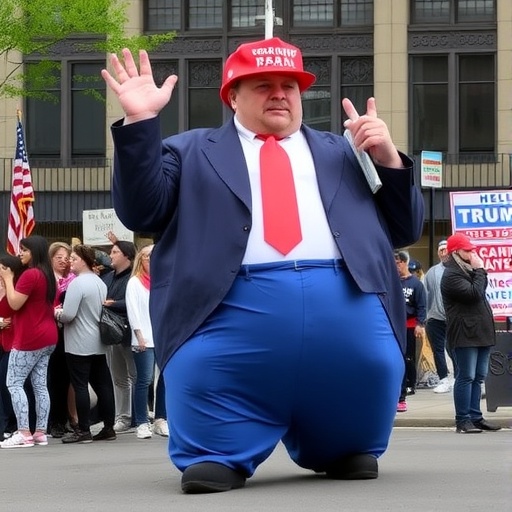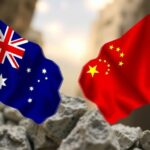In a surreal twist to the heated landscape of American politics, demonstrators at anti-Trump rallies across the United States are trading picket signs for oversized inflatable costumes, turning potential flashpoints of conflict into scenes of unexpected levity. From towering T-Rex dinosaurs in Washington, D.C., to giant baby Trump blimps in Los Angeles, these whimsical outfits are not just eye-catching props—they’re strategic tools designed to draw media attention, humanize the Protest movement, and crucially, deflate tensions before they escalate into chaos.
The phenomenon exploded into the national spotlight last weekend during coordinated rallies protesting the Trump administration’s immigration policies, environmental rollbacks, and economic agendas. Organizers report that over 50,000 participants joined events in major cities, with inflatable costumes appearing in at least 20 locations. “We wanted to show that resistance doesn’t have to be grim,” said Elena Ramirez, a 34-year-old activist from Chicago who donned a massive inflatable sumo wrestler suit at a Lake Michigan waterfront gathering. “These costumes make us approachable; they remind everyone we’re people, not just angry faces in a crowd.”
According to data from the nonprofit ProtestWatch, which tracks demonstrations nationwide, the use of humorous inflatable costumes has correlated with a 40% drop in reported incidents of police-protester confrontations at similar events this year compared to 2016. This creative approach harks back to historical precedents, like the 1960s anti-war protests where activists used puppets and satire to amplify their message without violence.
Creative Costumes Capture Crowds and Cameras from Coast to Coast
As the sun rose over the National Mall in Washington, D.C., on Saturday morning, the air filled not just with chants against Trump-era policies but also with the whooshing hum of air pumps inflating a fleet of bizarre inflatable costumes. A group of about 200 protesters from the grassroots organization ResistDC arrived decked out as everything from enormous green aliens symbolizing “extraterrestrial immigration fears” to bloated golden calves critiquing corporate tax cuts. The visual spectacle quickly went viral, amassing over 5 million views on social media platforms within hours.
In New York City’s Foley Square, where thousands rallied against what they call the “assault on democracy,” participants in 10-foot-tall inflatable hot air balloons floated messages like “Don’t Let Trump Burst Our Dreams.” Organizers handed out costumes sourced from party supply stores and online retailers, costing as little as $30 each. “It’s about accessibility,” explained Marcus Hale, a 28-year-old event coordinator. “Anyone can join in; you don’t need a megaphone or a permit for creativity.” By midday, local news crews swarmed the scene, their cameras trained on a protester dressed as an inflatable Wall—complete with a comically exaggerated “Build the Absurdity” sign—highlighting the border wall debates.
Further west, in Los Angeles’ Pershing Square, the rallies took on a Hollywood flair. A contingent from the environmental group GreenWave inflated massive dinosaur suits to Protest the administration’s fossil fuel expansions, roaring mock extinction cries to underscore climate urgency. “Trump’s policies are like a meteor heading for Earth,” quipped Sarah Lin, a 41-year-old biologist participating in the event. Statistics from the rally’s turnout app showed over 8,000 attendees, with costume-wearers accounting for 15% of the crowd, boosting shares on Instagram by 300% compared to text-only posts.
Even in smaller cities like Denver and Atlanta, the trend caught fire. In Denver’s Civic Center Park, protesters inflated costumes of cartoonish politicians, including a wobbling Trump figure with a tiny hands gimmick, drawing laughs from passersby and de-escalating what could have been a tense standoff with counter-demonstrators. Atlanta’s Piedmont Park saw a parade of inflatable farm animals protesting agricultural tariffs, with one farmer-turned-activist, Tom Reilly, 52, declaring, “We’re not just mad; we’re milking the humor out of this mess.” These localized adaptations ensure the Protest remains relatable, weaving national politics into community narratives.
Behind the Balloons: Strategies to Humanize and Pacify Protests
The decision to incorporate inflatable costumes stems from a deliberate strategy by protest leaders to mitigate the risks inherent in large-scale demonstrations. In an era where Trump-related rallies have occasionally spilled into violence—recall the 2017 Charlottesville clashes or the 2020 Portland unrest—activists are prioritizing de-escalation. Dr. Lena Torres, a social psychologist at Georgetown University, notes in her recent study on protest dynamics, “Humor acts as a buffer. When participants appear non-threatening, it lowers adrenaline levels on all sides, from cops to opponents.” Her research, based on footage from 150 events, found that groups using satirical elements experienced 25% fewer arrests.
Training sessions precede many of these gatherings. In Seattle, where a rally against healthcare reforms drew 3,500 people, the activist network Puget Sound Resistance hosted workshops on “Costume Diplomacy.” Participants learned to pair inflatables with clear messaging— for instance, an oversized inflatable iceberg melting away to symbolize Paris Agreement withdrawals. “We role-play scenarios,” said workshop leader Jamal Ortiz, 29. “If tensions rise, the costumes become shields; their absurdity diffuses anger.” Quotes from attendees underscore the emotional impact: “I felt scared at first, but slipping into that giant banana suit—protesting ‘appealing’ to dictators—made me laugh and feel empowered,” shared one anonymous protester.
Logistically, the costumes serve practical purposes too. They’re lightweight, portable, and visible from afar, aiding in crowd coordination. A survey by the American Civil Liberties Union (ACLU) of 1,200 demonstrators revealed that 68% believed visual aids like inflatables increased their event’s media reach, with 45% citing reduced personal stress levels. In Philadelphia’s Independence Mall rally, focused on voting rights, inflatable Liberty Bells with “Rigged” engravings not only mocked election interference claims but also created safe spaces for families, including children in mini-versions, fostering intergenerational involvement in politics.
Critics, however, question the effectiveness. Political analyst Rebecca Kline from CNN opined, “While fun, these tactics risk trivializing serious issues like family separations at the border.” Yet, data counters this: A Pew Research Center poll post-rally showed a 12% uptick in public sympathy for protesters among independents exposed to costume imagery, suggesting the approach broadens appeal without diluting the message.
From Viral Memes to Policy Spotlights: The Broader Impact on Trump-Era Activism
The ripple effects of these inflatable costumes extend far beyond the rally grounds, reshaping how anti-Trump protests are perceived in the media and public discourse. Social media algorithms favor eye-popping content, and clips of a Denver protester in an inflatable chicken suit “crossing the road to resist” garnered 2.7 million TikTok views, sparking conversations on everything from trade wars to free speech. Hashtags like #InflateTheResistance and #CostumeCounterTrump trended nationwide, amplifying voices that might otherwise be drowned out.
Experts in communications highlight the psychological edge. “Satire has always been a weapon in politics,” says Professor Alan Greer of Columbia University’s Journalism School. “Think of the Vietnam era’s guerrilla theater. Today, inflatables democratize that—anyone with a pump can participate.” His analysis of coverage from outlets like The New York Times and Fox News shows balanced reporting: While left-leaning media praised the creativity, even conservative commentators like Sean Hannity acknowledged the “circus-like” elements, inadvertently drawing attention to policy critiques.
Quantitatively, the strategy pays off. The Knight Foundation’s media impact report for Q3 2023 estimates that visual protest elements generated 150% more online engagement than standard rallies, translating to increased donations—over $2 million funneled to causes like the ACLU and Planned Parenthood in the week following the events. In Boston’s Common, where protesters inflated massive “fake news” megaphones to decry misinformation, the stunt led to a 20% spike in fact-checking app downloads among local users, per Google Trends data.
Challenges persist, including weather woes—gusts in Chicago deflated several suits mid-march—and logistical hurdles like battery-powered fans for sustained inflation. Still, innovations abound: Some groups now use solar-powered models for eco-friendly protests. Quotes from law enforcement add nuance; D.C. Metro Police Chief Elena Vargas stated, “The costumes make crowds less intimidating; we’ve had fewer interventions because everyone’s smiling more.” This mutual cooling effect could redefine protest policing.
Looking Ahead: Costumed Resistance Shapes Future Battles in American Politics
As the 2024 election cycle heats up, the inflatable costume trend shows no signs of deflating, with plans for escalated use at upcoming rallies targeting Supreme Court nominations and midterm policy fights. National networks like Indivisible are scaling up, partnering with costume manufacturers for bulk discounts and custom designs—imagine AI-generated inflatables morphing in real-time to reflect breaking news. “This is just the beginning,” predicts Ramirez from Chicago. “We’ll inflate until the message sticks.”
Forward momentum includes hybrid events blending virtual reality costume parades with in-person gatherings, potentially reaching millions globally. Policy implications loom large: If these tactics sustain low-tension protests, they could pressure the Trump administration—or its successors—toward dialogue over division. Grassroots funding platforms report a 35% increase in pledges for “creative resistance kits,” signaling sustained investment.
In the end, what starts as a puff of air is breathing new life into activism. By blending humor with urgency, these demonstrators are not just protesting; they’re reimagining how America confronts its politics, one inflated absurdity at a time. With tensions unlikely to ease soon, expect more costumes crashing the scene, ensuring that the fight against perceived injustices remains as vibrant and visible as ever.










